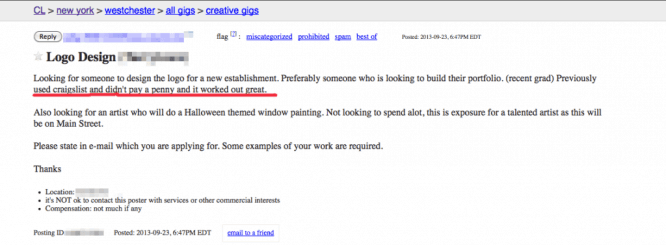Unpaid work and the value of graphic designers
Unpaid work and the value of graphic designers
Recently I saw a site that was “held hostage” by a web designer. On a gray background there was an inscription in large letters “Site unavailable”. Below it was signed “This site will be unavailable until the company pays the agreed amount to its designer.”
In fact, I do not quite agree with this act. Such behavior of the designer only attracts legal proceedings. Even if the truth is on his side, which is likely, this act is still on the verge of defamation. But this case serves as an example of a common problem in our time.

Thanksgiving work is very common in design.
What kind of work is this?
Self-risk work is a job where the client wants to get the finished project before he pays the designer, if he pays at all. But not all work that you don’t get paid for fits this description. The American Institute of Graphic Arts has listed several types of unpaid work:
Work at your own risk (“spec work”): work done for free in the hope that it will be paid
Work on a competitive basis: work done in the hope of winning a prize – whatever form it takes
Volunteering: working as a favor or for the purpose of gaining experience, without waiting for payment
Internship: a form of volunteer work whose purpose is education
Volunteer work: volunteer work done “for the public good”.
There are two reasons why customers use this type of design work. First, they are freeloaders and want to exploit inexperienced designers by requiring work to be done for minimal pay or through their influence – their favorite currency for designers. Secondly, they simply do not know how else to evaluate the work of these designers (Yes, and there are such designers).
So it all depends on how much the designer evaluates himself.

How much do you rate yourself?
When you just finished your design courses, you may have reasons to underestimate yourself. You need to gain experience or build a portfolio, so you can get the job done for little or no pay.
There is a vicious circle in the graphic design industry: in order to get a job, you must have experience that is impossible without a job. Working for free is the only solution, right?

But the fact is that you can build a portfolio or a client base without resorting to such work. For example, if you work for a portfolio, go to a local nonprofit with a partnership offer. This can be a school, university, or student organizations.
Make promotional materials for them or create a website to get more people to know about them. Students and nonprofits often don’t have the budget to pay for a designer, so this can be a great help for them. If you work well together, you can get a repeat customer for the future.
Thanksgiving work hurts the industry as a whole
I know that for the above reasons, this kind of work is taking place, but the bottom line is that it affects the industry as a whole. When you don’t charge for your work, you only strengthen that position, which affects the industry as a whole.
First, it negatively affects both you and other designers, current and future. Customers can see this as an opportunity to profit and get a job for free, which leads to abuse. In the long run, this practice devalues the designer’s work. If this becomes commonplace, then many designers will have to lower their price tag or try their luck by participating in design “contests”.
Second, it hurts the client too, believe it or not. Unpaid work only leads to mediocre results. Due to the low cost or lack of payment, the client gets exactly what he pays. Most often, in such cases, the designer puts little effort into the work. I know that I will not spend a lot of time and effort on a logo if I consider the option that it will not be paid. Worst of all, some plagiarize for their five bucks. Ultimately, the customer pays even more.
Source: ucreative.com
Cover photo: ShutterStock
Translation: Katerina Sorokina
…


